MASSACHUSETTS INSTITUTE OF TECHNOLOGY
LINCOLN LABORATORY
ADAPTIVE DETECTION AND PARAMETER ESTIMATION
FOR MULTIDIMENSIONAL SIGNAL MODELS
E.J. KELLY
Group 61
X.M. FORSYTHE
Group 44
copy
'/
I
TECHNICAL REPORT "84
,
i " '
... .
;
i
.
..
.
.
.
.
19 APRIL 1989..
Approved for public release; distribution is unlimited.
LEXINGTON
MASSACHUSETTS
�
"ABSTRACT
The problem of target detection and signal parameter estimation in a
background of unknown interference is studied, using a multidimen-
sional generalization of the signal models usually employed for radar,
sonar, and similar applications The required techniques of multivariate
statistical
_a:lysis are developed and extensively used throughout the
stud:, and the necessary mathematical background is provided in
Appendices. Target detection performance is shown to be governed by a
form of the Wilks' Lambda statistic, and a new method for its numeri-
cal evaluation is given which applies to the probability of false alarm of
the detector. Signal parameter estimation is shown to be directly related
to known techniques of adaptive nulling, and several new results rele-
vant to adaptive nulling performance are obtained.
Ill
�
TABLE OF CONTENTS
Abstract
INTRODUCTION AND PROBLEM FORMULATION
THE GENERALIZED LIKELIHOOD RATIO (GLR) TEST
STATISTICAL PROPERTIES OF THE GLR TEST
STATISTIC
THE PROBABILITY OF FALSE ALARM
THE ESTIMATION OF SIGNAL PARAMETERS
THE PROBABILITY OF DETECTION FOR THE
GLR TEST
1.
2.
3.
4.
5.
6.
7.
A GENERALIZATION OF THE MODEL
APPENDIX 1. MATHEMATICAL BACKGROUND
APPENDIX 2. COMPLEX DISTRIBUTIONS RELATED TO
THE GAUSSIAN
APPENDIX 3. INTEGRATION LEMMAS AND INTEGRAL
REPRESENTATIONS
APPENDIX 4. AN ALTERNATIVE DERIVATION OF THE
GLR TEST
APPENDIX 5. THE CONSTRAINT ON THE DIMENSIONAL
PARAMETERS
V
iii
1
9
31
47
59
95
119
133
167
175
205
215
�
APPENDIX 6. NUMERICAL COMPUTATION OF THE FALSE
ALARM PROBABILITY
APPENDIX 7. COMPUTATIONAL ALGORITHMS
REFERENCES
221
233
241
vi
�
1. INTRODUCTION AND PROBLEM FORMULATION
The basic physical model which motivates this study corresponds to an array of
sensors of some kind, positioned in an arbitrary way in space, and providing inputs to
a processor whose nature is the subject of the analysis. One "sample" is a set of out-
puts from this array, arranged as a vector. These samples may come directly from
the elements of the array, or they may be the outputs from a beamforming network
of some kind. We use complex variables to represent the data since we are concerned
with signals which modulate a carrier. Then the real and imaginary parts of a com-
plex quantity represent the in-phase and quadrature components of such a signal.
The modifications required to deal with real data are generally straightforward.
The basic data set upon which a processor will operate is a collection of sample
vectors, arranged as the columns of a rectangular data array. We do not wish to
specify the physical arrangements in greater detail because the mathematical model
itself is applicable to many diverse systems which may use adaptive processing of
array outputs in the radar, optical, and acoustical fields, and so on Indeed, the ele-
ments of the sample vectors could easily have a significance other than the direct
outputs of some set of sensors. However, we wish to draw etl.ention to certain basic
assumptions made in our model which, in certain cases, will limit its relevance.
We model the data array as a set of Gaussian random variables, and the covari-
ance structure of the modei is used to characterize the "noise" component of the
data, including both system noise and any random external interference. On the other
hand, "signals" are considered to be more structured contributions to the input, and
these are modeled by making appropriate assumptions about the mean values of the
elements of the data array. The emphasis here is on the detection of these signals
and the estimation of their parameters, and the most natural applications are to
radar or active sonar, where coherent processing is possible due to the known form of
the signals. In this study, a general linear model is used to represent signals.
Our strongest assumption concerning the covariance structure is a postulate of
stationarity: the sample vectors are assumed to be statistically independent and to
share a common covariance rmatrix. If the samples correspond to successive times,
then this is stationarity in the usual sense. However, the concept can be applied in
other ways. Fbr example, in the iadar case the samples may correspond to successive
range bins; but the data may already have been subjected to some form of processing
embracing a larger interval of time, such as Fourier transformation (Doppler process-
ing) of the array outputs before the adaptive phase of the process in which we are
interested.
I
II
II
I
I r
I
ll
i
'
i
_i
.n
a I
.1
�
Another strong assumption is that the covariance matrix of the sample vectors
is completely unknown. The advantage of this assumption is that it makes the math-
ematics more tractable, and also leads to a decision rule for which the probability of
false alarm is independent of the actual covariance structure of the interference. This
is a highly desirable feature, much stronger than the usual constant-false-alarm-rate
(CFAR) property in which the false alarm rate is independent of the level of the noise.
The disadvantage of our model in this respect is that it includes no constraint on the
structure of the covariance matrix, other than the obvious one of positivity. This
generality results in a restriction on the signal parametrization to assure a meaning-
ful decision rule, a point discussed more fully in Appendix 5. We now proceed to a
detailed description of the model.
Let Z be a complex N x L data array whose elements are modeled as circular
complex Gaussian random variables. The columns of Z (i.e., the sample vectors) are
assumed to be independent and to share the covariance matrix S. This is expressed
by the formula
Cov(Z) =
e I-)
where ® stands for the Kronecker product, and IL is the L x L identity matrix. This
notation is defined in Appendix I. where several basic properties of random arrays
needed in this analysis are derived The more general problem, in which the matrix IL
is replaced by a given positive definite matrix in Equation (1-I). is easily transformed
into the model used here by post-multiplication of the data array by a suitable
"whitening" matrix.
The mean of Z is assumed to have the form
EZ = aBT,
(,-2)
where a (N x J) is a given array, B (J x M) is an array of signal amplitude parameters,
and T- (M x L) is also a given array. The fixed arrays a and T describe the assumed sig-
nal structure, as will be illustrated by examples. It is further postulated that the
rank of a is J
must be positive definite, a property we denote by E > 0. The decision will be based on
the Generalized Likelihood Ratio (GLR) principle,. and a GLR test is derived below. An
estimate of the signal parameter array B is also of considerable interest, and the
Maximum Likelihood (ML) estimator of B is automatically obtained in the derivation
of the test statistic.
As noted earlier, the GLR test has the CFAR property in that its probability of
false alarm (PFA) is completely independent of the actual covariance matrix of the
data. Under the null hypothesis, the GLR test turns out to be a complex version of
Wilks' A-statistic,2 which is well known in the literature of multivariate statistical
analysis. The PFA for this test will be evaluated by a technique of numerical integra-
tion in the complex plane. Complete results for the probability of detection (PD) are
obtained only in special cases, but certain general properties of the PD will be estab-
lished in Section 6.
The signal model introduced above allows considerable flexibility. The simplest
case corresponds to J = 1 and M = 1, in which the signal array is represented as a single
dyadic product. The T array becomes a column vector of N elements, and T is then a
row vector of L elements. A specific example of this case, in which a is a general vec-
tor and
r dl,O....0],
is discussed in References 3, 4, and 5. In this specialization, a may represent a steering
vector, as that concept is usualiy applied for adaptive arrays, and the model allows
signal contributions in only one sample vector. In this special case, it is often conven-
ient to normalize the a and T vectors to unity, which amounts to a simple redefini-
tion of the parameter B.
A dual version, featuring a general T vector and a a vector of the form
o :
i.
.. _ 0 1T
is treated in Reference 6, on the basis of a totally different physical model, Although
these special cases are really different versions of the same problem, and can be
transformed into one another by a coordinate change of the kind discussed below,
their analyses take rather different forms when they are carried out in the original
coordinates.
3
�
In the general model, the a array controls the distribution of signal contributions
among the rows of the data array, while -r controls their appearance among the col-
umns. If the components of the sample vectors represent the outputs from the sen-
sors of an array, then a will relate to the spatial character of the signals. Similarly. if
the sample vectors themselves correspond to successive instants of time (snapshots).
then T will describe the temporal aspects of the signals.
Two other cases, which are natural duals of one another, are direct generaliza-
tions of the examples given above. In the first, a is an arbitrary fixed array which
satisfies the rank constraint mentioned earlier and T is taken to be
T- = [I
0
(1-3)
where IM is the M x M identity, and the zero array here is M x (L - M) in dimension.
With this model signals appear in the first M columns only, and each of these is rep-
relented as a different linear combination of the columns of a. These latter columns
determine a J-dimensional subspace of the N-dimensional complex vector space C
This represents a generalization of the ordinary notion of an array steering vector. An
example of such a model for signals is provided by multipath, which commonly
occurs in seismic, acoustic, and "over the horizon" radar applications. For our model
to be to be directly applicable, however, the multipath characteristics associated with
a given principal signal component must be predictable, except for a set of complex
amplitude factors. Another example is one in which the signal spatial structure is
totally unknown, which corresponds to the special case J = N.
In the dual version, a is taken to have the form
Ij!
a=
(1-4)
and Tr is arbitrary (but full-rank), sc that signals are described as row vectors, con-
fined to the first J rows of Z. These row signals are independent linear combinations
of the rows of T which determine an M-dimensional subspace of the L-dimensional
complex vector space eL. The characteristic feature of the general problem is the
restriction of signals to subspaces in both the row and column directions, and the key
to its analysis is the use of mathematical techniques which are adapted to this geo-
metrical structure.
4
�

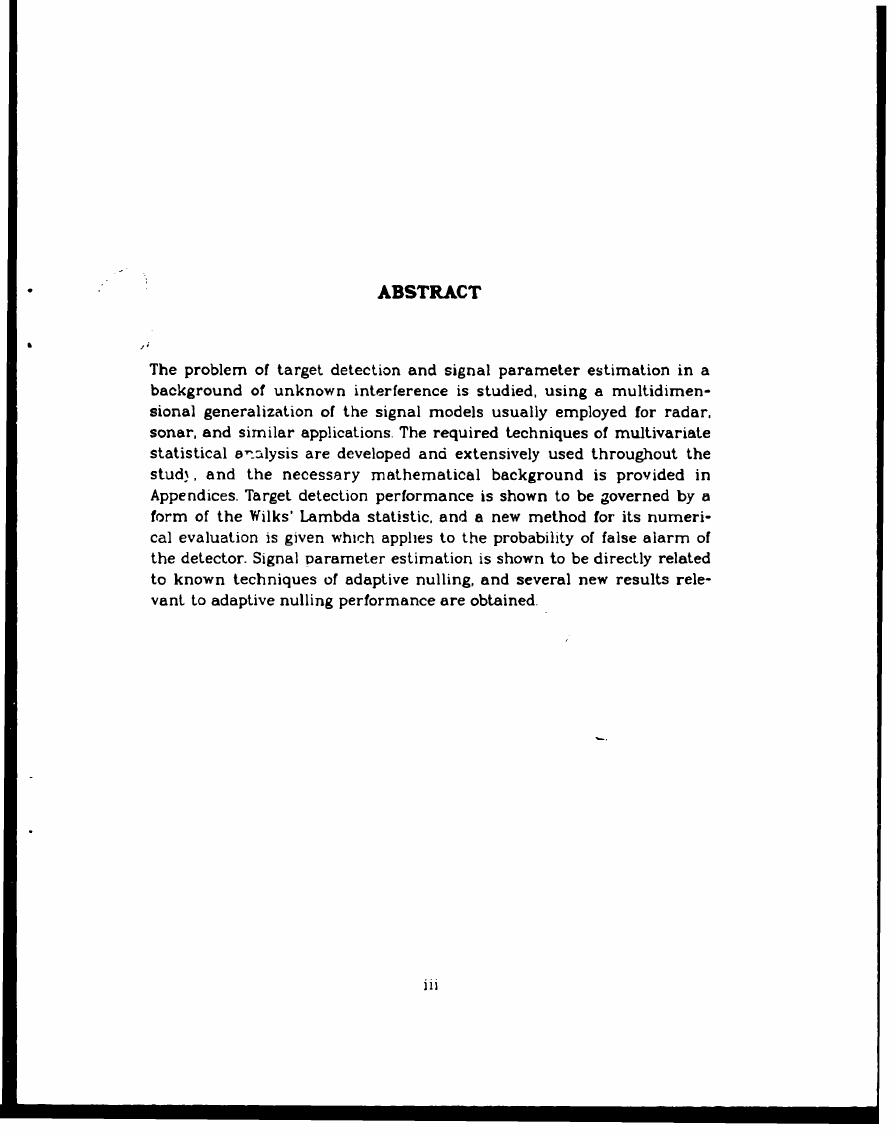
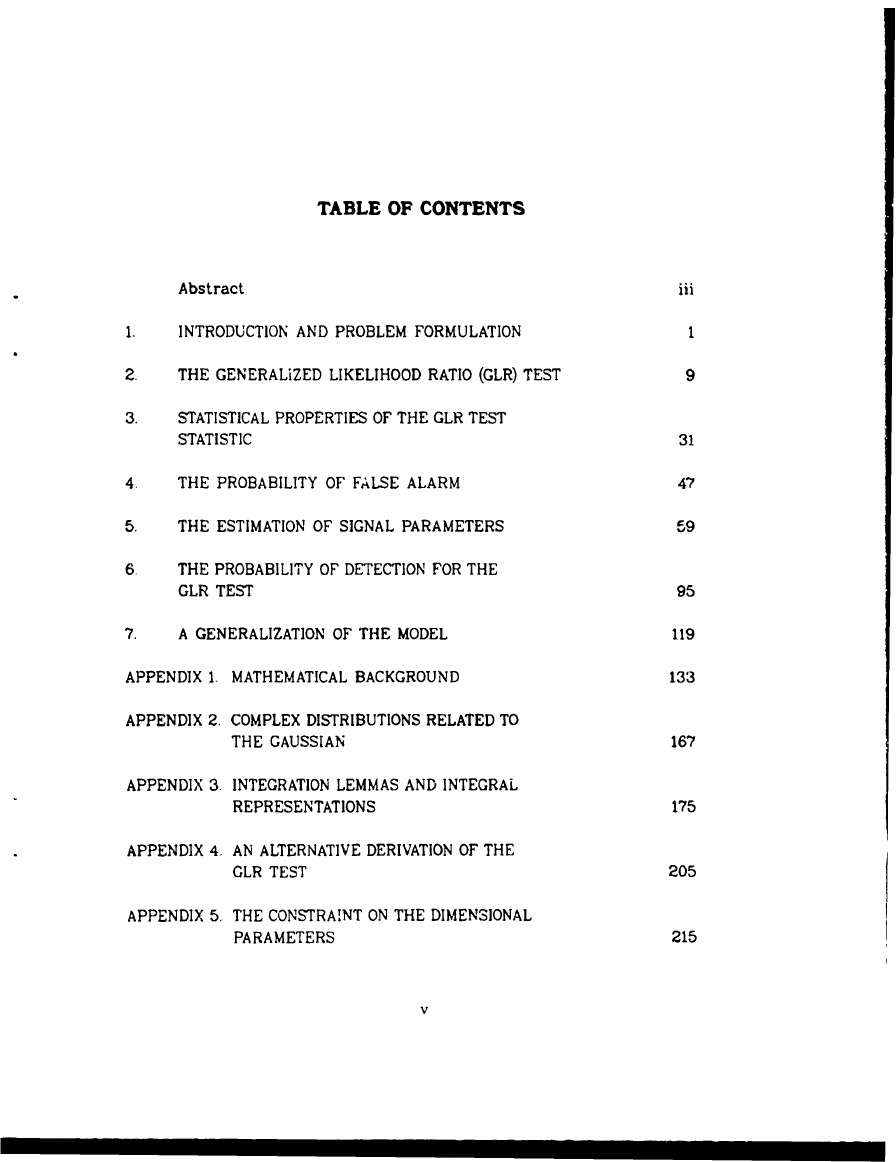


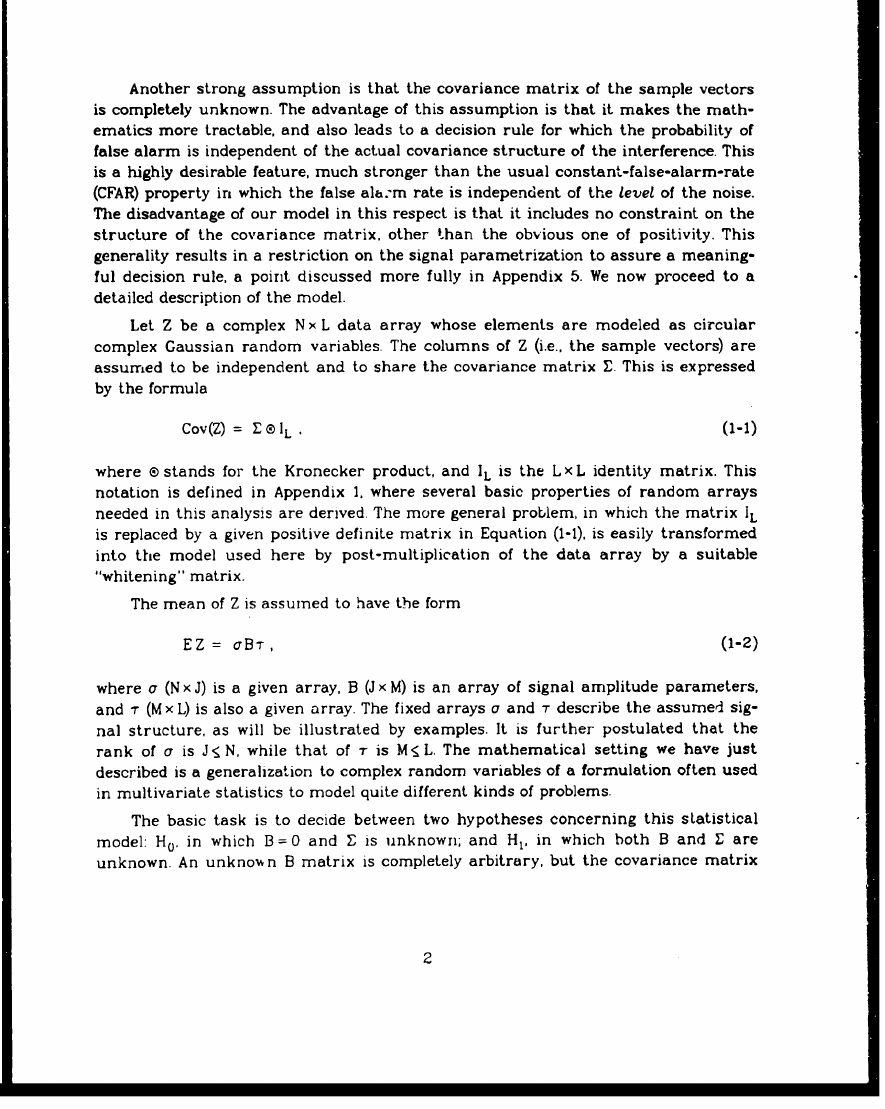
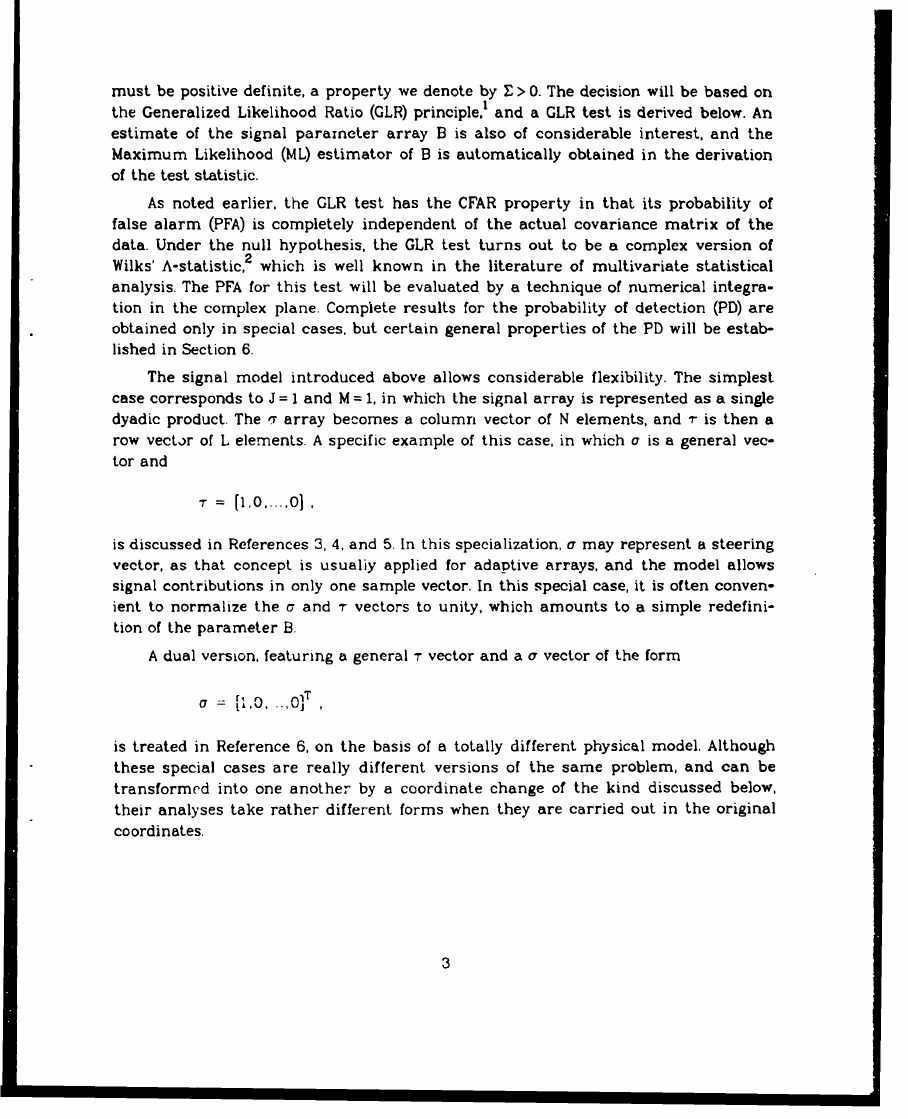
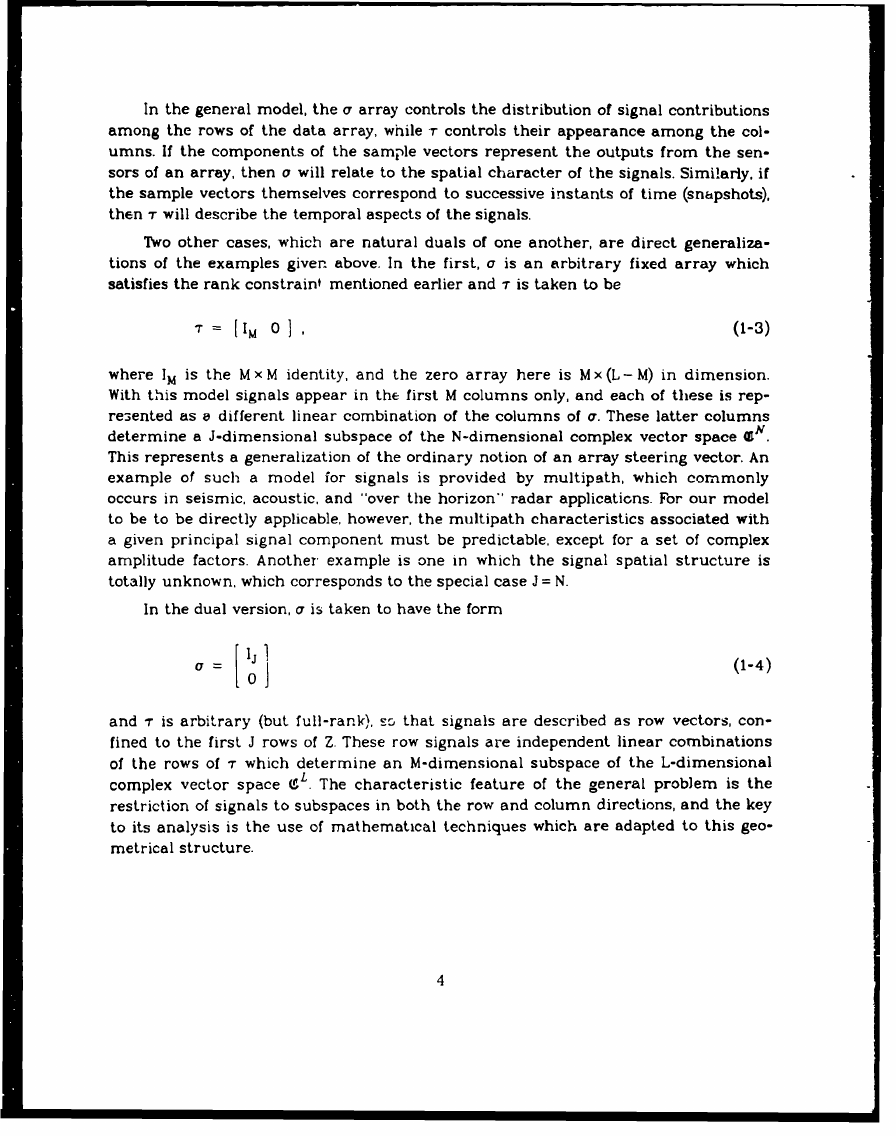








 2023年江西萍乡中考道德与法治真题及答案.doc
2023年江西萍乡中考道德与法治真题及答案.doc 2012年重庆南川中考生物真题及答案.doc
2012年重庆南川中考生物真题及答案.doc 2013年江西师范大学地理学综合及文艺理论基础考研真题.doc
2013年江西师范大学地理学综合及文艺理论基础考研真题.doc 2020年四川甘孜小升初语文真题及答案I卷.doc
2020年四川甘孜小升初语文真题及答案I卷.doc 2020年注册岩土工程师专业基础考试真题及答案.doc
2020年注册岩土工程师专业基础考试真题及答案.doc 2023-2024学年福建省厦门市九年级上学期数学月考试题及答案.doc
2023-2024学年福建省厦门市九年级上学期数学月考试题及答案.doc 2021-2022学年辽宁省沈阳市大东区九年级上学期语文期末试题及答案.doc
2021-2022学年辽宁省沈阳市大东区九年级上学期语文期末试题及答案.doc 2022-2023学年北京东城区初三第一学期物理期末试卷及答案.doc
2022-2023学年北京东城区初三第一学期物理期末试卷及答案.doc 2018上半年江西教师资格初中地理学科知识与教学能力真题及答案.doc
2018上半年江西教师资格初中地理学科知识与教学能力真题及答案.doc 2012年河北国家公务员申论考试真题及答案-省级.doc
2012年河北国家公务员申论考试真题及答案-省级.doc 2020-2021学年江苏省扬州市江都区邵樊片九年级上学期数学第一次质量检测试题及答案.doc
2020-2021学年江苏省扬州市江都区邵樊片九年级上学期数学第一次质量检测试题及答案.doc 2022下半年黑龙江教师资格证中学综合素质真题及答案.doc
2022下半年黑龙江教师资格证中学综合素质真题及答案.doc